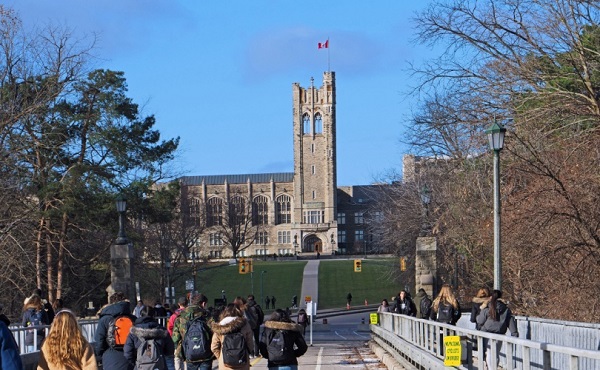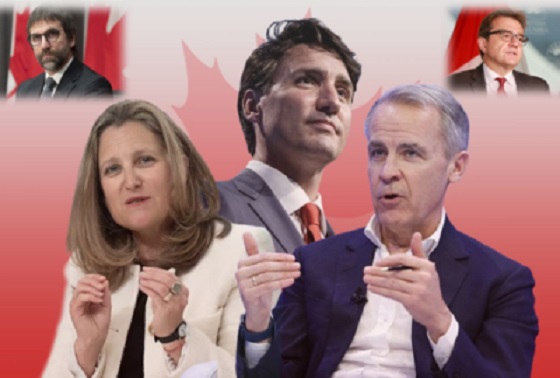Alberta
Open letter to Canada’s Premiers calling for pivot in response, end to lockdowns

Premiers,
It has been over one full year since the declaration of the Pandemic. SARS CoV-2 has been in Canada much longer than that, as you well know.
You are responsible for the response in each of your jurisdictions. While the Medical Officers of Health (MOH) are equally responsible for the advice they have given, you personally were elected to lead. They were not.
Your own statistics prove that for people under the age of 60, SARS CoV-2 is not something to be feared. In one full year, people under the age of 60 are twice as likely to die from a heart disease. For people 20 – 40 years old, they are five times more likely to die in a car accident. Worldwide 2.54 million people die from Pneumonic annually. SARS CoV-2 has killed under 2 Million in a year. The risk from SARS CoV-2 has been widely exaggerated, by you, your MOH and the media.
https://www.frontiersin.org/articles/10.3389/fpubh.2021.625778/full
For people over 60, your approach has failed our seniors.
Canada has ranked last in the Organization of Economically Developed Countries (OECD) in care of those most at risk to SARS CoV-2. Over 96% of all reported SARS CoV-2 deaths were in our seniors. Even Canada’s Chief Medical Officer of Health admitted this is Canada’s shame.
Your use of “lockdowns” did not save over 21,000 of our seniors. It failed them.
The use of Non-Pharmaceutical Interventions (NPIs) which we now call “lockdowns” was known to have little effect on the spread of infectious diseases long before SARS CoV-2 arrived. In fact, the World Health Organization (WHO) assembled the best infectious disease doctors in the world to write the 2019 version of “Non-Pharmaceutical Public Health Measures”. If you read the document, for a Pandemic of the severity of SARS CoV-2, most of these measures were not recommended for use. Yet we used almost all of them.
https://apps.who.int/iris/bitstream/handle/10665/329438/9789241516839-eng.pdf
Top infectious disease doctors in the world have proven in repeated detail peer reviewed research papers all over again that “lockdowns” do not have significant impacts on either the spread or deaths for SARS CoV-2. Yet you and the media constantly tell us they do. But one of the many in depth studies found: “While small benefits cannot be excluded, we do not find significant benefits on case growth of more restrictive NPIs. Similar reductions in case growth may be achievable with less‐restrictive interventions”.
https://onlinelibrary.wiley.com/doi/10.1111/eci.13484
What is also know is that “lockdowns” cause terrible collateral damage. The damage to Canadians Mental Health, Societal Health, Children’s Education and Social Development, Patients with other Severe Illnesses and to our National Economy (Federal and Provincial/Territorial) will continue, until you remove and promise never to inflict “lockdowns again. These impacts and deaths seem not to be considered in any cost benefit analysis by you or your MOH.
Many of the world’s experts have tried to help target the response to SARS CoV-2 to save the most vulnerable, while minimizing the effects on the rest of our population. You have ignored these experts. In fact, most of these experts have been completely censored by you, your MOH and the media.
Please read the attached Paper, “One Year of COVID-19 Pandemic Response in Canada”. The Paper states what we had collectively planned to do in a Pandemic, what we have done, and how to pivot out of our failed response.
It is time to stop.
Listen to all expert voices.
Pivot.
Thank you for your time.
David Redman
Lieutenant Colonel (Retired)
Former Head of Emergency Management Alberta
One Year of COVID-19 Pandemic Response in Canada March 31, 2021
David Redman
Former Head of Emergency Management Alberta
Emergency Management
Pandemics happen continuously. Since 1955, this is the world’s fifth pandemic. In the next fifty-five years there is going to be five more. We have never responded to a pandemic like we responded to COVID-19.
It must be clear that a pandemic is not a Public Health Emergency, it is a Public Emergency because all areas of society are affected: public sector, private sector, not- for-profit sector, and all citizens.
In Canada, we have an Emergency Management Process that we normally use in a pandemic. We have pre-written Pandemic Response plans. These plans were written incorporating the hard lessons learned from previous pandemics.
Part of the lessons learned from previous pandemics is contained in the World Health Organization (WHO) “Non-pharmaceutical public health measures for mitigating the risk and impact of epidemic and pandemic influenza” dated 2019.
This document included the world’s best studies and information on the use of 15 separate non-pharmaceutical interventions (NPIs). The use of these NPIs was discussed in the development of the existing Provincial Plans.
The 2019 WHO document was known, or should have been known, by all Medical Officers of Health in Canada. The use of each of the NPIs was dependant on the severity of the pandemic. Even in a High or Extraordinary Pandemic the use of all or most of these NPIs at the same time was not envisioned.
Prior to the use of each NPI, the Federal and Provincial/Territorial governments needed to demonstrably justify how each NPI would protect the life of Canadians. Some of the NPIs were not recommended for use in any pandemic, including:
- Contact Tracing (not recommended after first two weeks)
- Quarantine of Exposed Individuals
- Entry and Exit Screening
- Border Closures
One Year of COVID-19 Pandemic Response in Canada March 31, 2021
David Redman
Former Head of Emergency Management Alberta
Some of the NPIs were recommended for use only as a last resort, including: • Workplace Measures and Closures
Despite this, they were used as a first resort.
Some NPIs were not recommended for a pandemic with the severity of COVID-19, including:
- School Measures and Closures
- Face Masks for Public These recommendations were ignored.The lack of any attempt to publicly demonstrate a cost benefit analysis based on life and impact on lives shows a complete disregard for “Due Diligence” by both our Medical Officers of Health (MOH) and our Premiers.
In summary on NPIs, the collateral damage from the use of each NPI needed to be justified in a cost benefit analysis, showing not only what life saving could be expected, but what the short-term and long-term impact on lives would be. Further, it needed to be demonstrably shown why the WHO recommendations were ignored. This was never done for any of the NPIs invoked.
The aim of the pre-written pandemic plans is to allow our leaders to rapidly minimize the impact of a new pandemic on our society. The four goals of the pandemic plans are clearly defined:
• Controlling the spread of influenza disease and reducing illness (morbidity) and death (mortality) by providing access to appropriate prevention measures, care, and treatment.
• Mitigating societal disruption in Alberta through ensuring the continuity and recovery of critical services.
• Minimizing adverse economic impact.
• Supporting an efficient and effective use of resources during response and recovery
https://www.alberta.ca/pandemic-influenza.aspx#toc-1
The purpose in writing these plans in advance is to ensure the government could rapidly advise the public of the scope of the new hazard and publicly issue a complete written plan to address it. That way the public can see the entire plan, see the phases of the plan, and all steps that will be taken. The public understands their role in the plan. The response to the pandemic would then be coherent.
This has not happened.
One Year of COVID-19 Pandemic Response in Canada March 31, 2021
David Redman
Former Head of Emergency Management Alberta
The Canadian Response – Not Based on Emergency Management
The Canadian response to COVID-19 has been incoherent, constantly changing, and with no plan. The sole focus on COVID-19 case counts led to a completely flawed response trying to deal only with the first pandemic goal, and failing.
In February and March 2020 we knew that over 95% of the deaths in China and Europe were in seniors, over the age of 60, with multiple co-morbidities.
One Year of COVID-19 Pandemic Response in Canada March 31, 2021
David Redman
Former Head of Emergency Management Alberta
We should have immediately developed options for the protection of concentrations of our seniors over 60 with co-morbidities. Our Long Term Care (LTC) homes should have developed and offered quarantine options, for both the residents and the staff.
In our first full year of COVID-19 in Canada, 96% of our over 22,800 deaths have been in seniors, over the age of 60, with multiple co-morbidities. See Figure 5 in link below, updated weekly by Health Canada.
https://health-infobase.canada.ca/covid-19/epidemiological-summary-covid-19- cases.html
That is over 21,890 deaths. It is likely that thousands of these deaths could have been avoided, as over 80% of the deaths in the first wave occurred in LTC homes.
After one full year, we stand at 73% of the 22,880 deaths in LTC homes, 16,700 of our seniors. Our country ranked last in the OECD for protecting our seniors.
https://www.msn.com/en-ca/news/canada/canadas-nursing-homes-have-worst-record- for-covid-deaths-among-wealthy-nations-report/ar-BB1f76sw
This may have cost $2 billion, but could have saved over 16,700 lives as 73% of Canadian deaths have been in LTC homes in the first year of COVID-19. Instead we locked down healthy Canadians and our businesses and spent well over $240 billion to force over 8 million healthy Canadians to stay at home. The cost mounts daily.
https://www.cbc.ca/news/canada/tracking-unprecedented-federal-coronavirus-spending- 1.5827045
We did not need to follow the failed lock down practice of China or Europe. Lockdowns have not saved 21,890 of our Canadian seniors. We knew who was most at risk and had time to provide the option of quarantine for our seniors, both in LTC homes and in society. Instead, we sacrificed our seniors.
https://www.cnn.com/2020/05/26/world/elderly-care-homes-coronavirus-intl/index.html

In June 2020, the Canadian Institute for Health Information reported that Canada had a higher
proportion of COVID-19 deaths within LTC settings than other OECD countries included in its
comparison. At that time, deaths in Canadian LTCs from COVID-19 were at 81% of the total, while
OECD countries reported LTC COVID-19 deaths of 10-66% (average of 38%) of their totals.
The CBC News analysis has tracked $105.66 billion in federal payments to individuals; $118.37
billion that has gone to businesses, non-profits and charitable organizations; and a further
$16.18 billion in transfers to provinces, territories, municipalities and government agencies.

One Year of COVID-19 Pandemic Response in Canada March 31, 2021
David Redman
Former Head of Emergency Management Alberta
Our leaders and doctors constantly tell us we are in danger of overwhelming our medical system. If we had acted to quarantine our seniors’ long term care facilities, our hospital capacity would not have been challenged, as 71% of our hospital beds and 64% of our ICU capacity continue to this day to be filled with seniors. See Figure 5 in link below, updated daily by Health Canada.
https://health-infobase.canada.ca/covid-19/epidemiological-summary-covid-19- cases.html
We would not have needed to stop other medical procedures.
https://lfpress.com/opinion/columnists/goldstein-canadas-medical-wait-times-longest- ever-because-of-covid-19
We should never have forced healthy medical staff to self-isolate. We should have made rapid testing a priority for all orders of government.
We ignored the other three goals of our pre-existing pandemic plans:
• Mitigating societal disruption in Alberta through ensuring the continuity and recovery of critical services.
• Minimizing adverse economic impact.
• Supporting an efficient and effective use of resources during response and recovery
Ignoring these three goals and following a failed lockdown response has caused massive collateral damage in terms of deaths and long-term effects on our population. Collateral damage, largely ignored by mainstream media, includes but is not limited to:
- Societal health,
- Mental health,
- Other health conditions,
- Children’s education and social development,
- Economic healthhttps://pandemicalternative.org/ https://collateralglobal.org/
We are told that lockdowns (i.e. the persistent use of NPIs) has decreased the spread and deaths from COVID-19. Therefore, it is assumed that the collateral deaths are somehow justified. Nothing could be further from the truth.



One Year of COVID-19 Pandemic Response in Canada March 31, 2021
David Redman
Former Head of Emergency Management Alberta
We knew from the WHO 2019 NPI document cited earlier that the use of most NPIs have little effect on the spread of a virus. It was a lesson learned. Unfortunately, it had to be proved again through studies by some of the best infectious disease doctors in the world. One such study on the spread of COVID-19 is quoted:
“European Journal of Clinical Investigation
Assessing mandatory stay‐at‐home and business closure effects on the spread of
COVID‐19
Methods
We first estimate COVID‐19 case growth in relation to any NPI implementation in subnational regions of 10 countries: England, France, Germany, Iran, Italy, Netherlands, Spain, South Korea, Sweden and the United States. Using first‐difference models with fixed effects, we isolate the effects of mrNPIs by subtracting the combined effects of lrNPIs and epidemic dynamics from all NPIs. We use case growth in Sweden and South Korea, 2 countries that did not implement mandatory stay‐at‐home and business closures, as comparison countries for the other 8 countries (16 total comparisons).
Conclusions
While small benefits cannot be excluded, we do not find significant benefits on case growth of more restrictive NPIs. Similar reductions in case growth may be achievable with less‐restrictive interventions.”
https://onlinelibrary.wiley.com/doi/10.1111/eci.13484
Further comment on deaths from COVID-19 and non-lockdown countries compared to lockdown countries:
https://off-guardian.org/2021/03/23/lockdown-one-year-on-it-doesnt-work-it-never- worked-it-wasnt-supposed-to-work/
COVID-19 has followed the annual seasonal infection curve almost exactly, in spite of lockdowns in our country. Our MOH and Premiers take credit for the seasons when it is in their favour and blame their citizens when seasons dictate “exponential increases”. Our Premiers and MOHs continue to abandon our Emergency Management Process and give in to fear.

One Year of COVID-19 Pandemic Response in Canada March 31, 2021
David Redman
Former Head of Emergency Management Alberta
Conclusions – An Emergency Management and Science Based Way Ahead
Canadians deserve a confidence-based response to the COVID-19 pandemic and all future pandemics. An eight-point process is proposed for the immediate future:
|
1. Releaseacomprehensive,FourGoal-basedPandemicPlan,showingwhatis to be done phase by phase, and what the public’s role is in each phase. |
|
One Year of COVID-19 Pandemic Response in Canada March 31, 2021
David Redman
Former Head of Emergency Management Alberta
7. Geteveryoneunder65withoutpre-existingcompromisedimmune systems, who can and want to work, fully back to work.
8. Continuetovaccinateassafeandeffectivevaccinesbecomeavailable,for the current strain of COVID-19.
Canada’s Response to COVID-19 After One Year
Alberta
Alberta takes big step towards shorter wait times and higher quality health care

From the Fraser Institute
On Monday, the Smith government announced that beginning next year it will change the way it funds surgeries in Alberta. This is a big step towards unlocking the ability of Alberta’s health-care system to provide more, better and faster services for the same or possibly fewer dollars.
To understand the significance of this change, you must understand the consequences of the current (and outdated) approach.
Currently, the Alberta government pays a lump sum of money to hospitals each year. Consequently, hospitals perceive patients as a drain on their budgets. From the hospital’s perspective, there’s little financial incentive to serve more patients, operate more efficiently and provide superior quality services.
Consider what would happen if your local grocery store received a giant bag of money each year to feed people. The number of items would quickly decline to whatever was most convenient for the store to provide. (Have a favourite cereal? Too bad.) Store hours would become less convenient for customers, alongside a general decline in overall service. This type of grocery store, like an Alberta hospital, is actually financially better off (that is, it saves money) if you go elsewhere.
The Smith government plans to flip this entire system on its head, to the benefit of patients and taxpayers. Instead of handing out bags of money each year to providers, the new system—known as “activity-based funding”—will pay health-care providers for each patient they treat, based on the patient’s particular condition and important factors that may add complexity or cost to their care.
This turns patients from a drain on budgets into a source of additional revenue. The result, as has been demonstrated in other universal health-care systems worldwide, is more services delivered using existing health-care infrastructure, lower wait times, improved quality of care, improved access to medical technologies, and less waste.
In other words, Albertans will receive far better value from their health-care system, which is currently among the most expensive in the world. And relief can’t come soon enough—for example, last year in Alberta the median wait time for orthopedic surgeries including hip and knee replacements was 66.8 weeks.
The naysayers argue this approach will undermine the province’s universal system and hurt patients. But by allowing a spectrum of providers to compete for the delivery of quality care, Alberta will follow the lead of other more successful universal health-care systems in countries such as Australia, Germany, the Netherlands and Switzerland and create greater accountability for hospitals and other health-care providers. Taxpayers will get a much better picture of what they’re paying for and how much they pay.
Again, Alberta is not exploring an untested policy. Almost every other developed country with universal health care uses some form of “activity-based funding” for hospital and surgical care. And remember, we already spend more on health care than our counterparts in nearly all of these countries yet endure longer wait times and poorer access to services generally, in part because of how we pay for surgical care.
While the devil is always in the details, and while it’s still possible for the Alberta government to get this wrong, Monday’s announcement is a big step in the right direction. A funding model that puts patients first will get Albertans more of the high-quality health care they already pay for in a timelier fashion. And provide to other provinces an example of bold health-care reform.
Alberta
Alberta’s embrace of activity-based funding is great news for patients

 From the Montreal Economic Institute
From the Montreal Economic Institute
Alberta’s move to fund acute care services through activity-based funding follows best practices internationally, points out an MEI researcher following an announcement made by Premier Danielle Smith earlier today.
“For too long, the way hospitals were funded in Alberta incentivized treating fewer patients, contributing to our long wait times,” explains Krystle Wittevrongel, director of research at the MEI. “International experience has shown that, with the proper funding models in place, health systems become more efficient to the benefit of patients.”
Currently, Alberta’s hospitals are financed under a system called “global budgeting.” This involves allocating a pre-set amount of funding to pay for a specific number of services based on previous years’ budgets.
Under the government’s newly proposed funding system, hospitals receive a fixed payment for each treatment delivered.
An Economic Note published by the MEI last year showed that Quebec’s gradual adoption of activity-based funding led to higher productivity and lower costs in the province’s health system.
Notably, the province observed that the per-procedure cost of MRIs fell by four per cent as the number of procedures performed increased by 22 per cent.
In the radiology and oncology sector, it observed productivity increases of 26 per cent while procedure costs decreased by seven per cent.
“Being able to perform more surgeries, at lower costs, and within shorter timelines is exactly what Alberta’s patients need, and Premier Smith understands that,” continued Mrs. Wittevrongel. “Today’s announcement is a good first step, and we look forward to seeing a successful roll-out once appropriate funding levels per procedure are set.”
The governments expects to roll-out this new funding model for select procedures starting in 2026.
* * *
The MEI is an independent public policy think tank with offices in Montreal, Ottawa, and Calgary. Through its publications, media appearances, and advisory services to policymakers, the MEI stimulates public policy debate and reforms based on sound economics and entrepreneurship.
-

 2025 Federal Election1 day ago
2025 Federal Election1 day agoRCMP memo warns of Chinese interference on Canadian university campuses to affect election
-

 2025 Federal Election2 days ago
2025 Federal Election2 days agoConservative Party urges investigation into Carney plan to spend $1 billion on heat pumps
-

 Alberta2 days ago
Alberta2 days agoAlberta takes big step towards shorter wait times and higher quality health care
-

 2025 Federal Election2 days ago
2025 Federal Election2 days agoFifty Shades of Mark Carney
-

 2025 Federal Election19 hours ago
2025 Federal Election19 hours agoResearchers Link China’s Intelligence and Elite Influence Arms to B.C. Government, Liberal Party, and Trudeau-Appointed Senator
-

 2025 Federal Election2 days ago
2025 Federal Election2 days agoCorporate Media Isn’t Reporting on Foreign Interference—It’s Covering for It
-

 Business2 days ago
Business2 days agoTrump raises China tariffs to 125%, announces 90-day pause for countries who’ve reached out to negotiate
-

 2025 Federal Election1 day ago
2025 Federal Election1 day agoThe status quo in Canadian politics isn’t sustainable for national unity






















